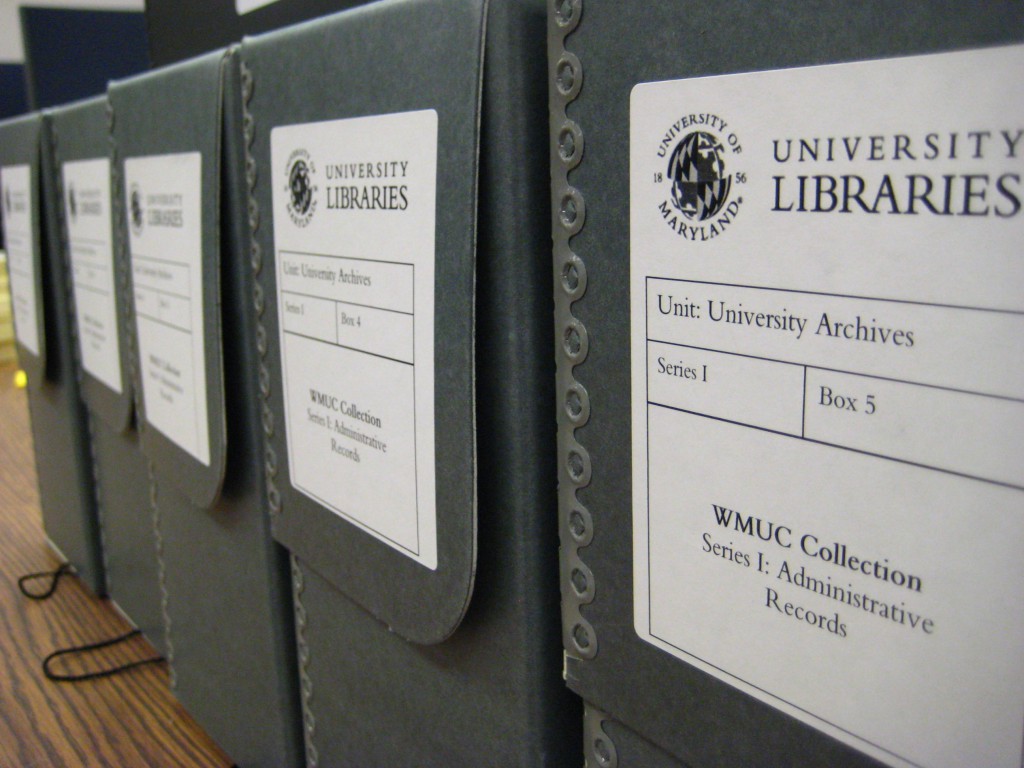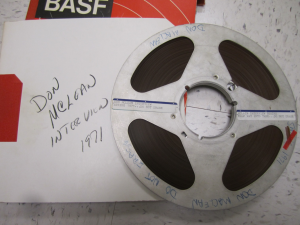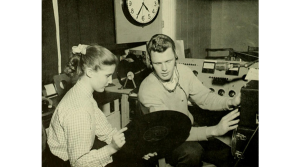Saving College Radio

WMUC Archives, 2012.
Post by Laura Schnitker, University of Maryland, College Park
On March 26, 1971, an up-and-coming folk singer named Don McLean sat down for an interview at WMUC, the University of Maryland’s student-run radio station. Soft-spoken and thoughtful, McLean discussed a number of topics with DJ Craig Allen, including American music history, environmentalism, and contemporary singer-songwriters. When the conversation turned toward the tensions between commercialism and folk music, McLean introduced a new song. “Take you back about ten years ago when Buddy Holly died,” he explained as he tuned his guitar. “He was my idol. He’s the only idol I ever had. This is a rather long song,” he warned, “so better light up.” McLean then launched into an early rendition of “American Pie.”
Since it would be another two months before McLean’s iconic and best-known song debuted on commercial radio, its audition for a college audience is well-placed among historic gems of American popular music. And it might have been lost forever had it not been recorded and preserved on a 10” audio reel tape that floated around WMUC for over three decades before I spotted it in 2008. I was interviewing the general manager for the college radio chapter in my dissertation when I noticed a tape box on his desk with the inscription, “Interview with Don McLean, Spring 1971. DO NOT ERASE”. I asked if there were any more like it.

WMUC’s Don McLean reel from 1971.
Quite a few, in fact. Over 1,800 audio reels, cartridges, cassettes, and DATs documenting WMUC’s unique history were stacked to the ceiling in a dark, dusty storage room in the back of the station. Some of them were lying under piles of old equipment. Some were tangled in long tails of audio tape that had fallen off their cores. And with no climate control, the natural deterioration of magnetic tape in flimsy cardboard boxes happens at a much quicker pace. These recordings badly needed to be saved. But what constitutes “saving” beyond merely keeping something out of the trash, and whose responsibility is it to do so at a college radio station? Furthermore, what value might college radio archives have beyond the occasional interview with a Pretty Famous Musician?
One thing I’ve learned in the 10 years I’ve been archiving broadcast history is that radio stations have been notoriously remiss in preserving their histories. If they saved anything it was usually printed records; audio recordings were most often destroyed after the stations were reformatted or sold. With no aftermarket for old broadcasts, and the added complications of performance copyright and rapidly changing sound technologies, many station managers probably thought these recordings were more liability than asset. A large portion of the audio collections I manage at the University of Maryland Libraries came from unionized, dumpster-diving sound engineers whose appreciation for their historic value outweighed everything else.
College radio archives are just as elusive. I’ve heard from participants at other campus stations who have described their own storage rooms of neglected recordings that no one knows how to manage, or even care about. I cringed when one station advisor told me that an old reel containing a remote broadcast of Woodstock was being used as a coaster by their current DJs. However, the difference here is that most colleges and universities have the built-in resources to both save their materials and provide public access to them. This is precisely what they should be doing.
As student organizations, campus radio stations are part of university life, and their historical records belong in their university archives. When I asked Maryland’s university archivist Anne Turkos to establish a WMUC Collection in 2011, we embarked on a mission to demonstrate the station’s importance to campus history. With the help of WMUC student staff members, we identified the historic audio and print items that were no longer being used and moved them to the more stable environment of the special collections library. We created inventories and a finding aid, and thanks to the libraries’ new media reformatting center we began ongoing digitization of the audio materials. Listening to them revealed a multi-faceted history I hadn’t expected to find. In addition to music, there was 50 years’ worth of news, sports, dramas, live performances, promos, community affairs and even self-help programming.

Pat Callahan & Herb Brubaker, WMUC, 1955.
In 2013, we created a gallery and digital exhibit to honor the station’s 65th anniversary. “Saving College Radio: WMUC Past, Present and Future” opened in September of that year, and over 150 station alumni showed up to celebrate what had for many of them been the most important aspect of their college careers. They had been vital in helping us reconstruct the station’s history which forever changed my perception of college radio.
Like most people, I considered college radio a mostly anti-commercial musical format favoring the experimental, the up-and-coming, the never-heard-of, the sometimes-unlistenable. While this may be true, college radio should not be solely defined by its relationship to the music industry. Since the first student-run station almost a century ago, college radio has represented empowerment and agency on many fronts: an opportunity for students to find their voices, gain hands-on technical experience, navigate local and federal policies, and influence campus culture. What’s missing from both popular and academic understandings of college radio are these unique station histories that illuminate how college radio stations are also shaped by their relationships to media, politics, geographical regions, campus administrations, the student bodies and the students who run them.
Beyond its significance to popular culture, the Don McLean interview marks an era in WMUC’s past when DJs were bent on professional careers as journalists, producers, and programmers. Many of them fashioned their broadcasts in early 1970s commercial parlance, while others emulated a then-fledgling NPR. It also reflects a time on campus when tensions between students and the administration were high; less than a year after the Kent State shootings, UMD students responded unfavorably to the police presence outside the Steppenwolf concert at Ritchie Coliseum (McLean was the opening act). Four years later, the next crop of students would dedicate their energies to obtaining an FM license, the ones after that to advocating for an all-freeform format. In this context, we see that college radio is not and has never been a fixed entity, but a continuously evolving collective of ever-changing identities.
Much debate surrounds the future of college radio, as streaming services and podcasts have shifted popular attention away from traditional broadcasters, and reports of recent NPR takeovers of college stations have some alarmists claiming that the latter’s demise is imminent. Of course, competition among noncommercial broadcasters for these coveted left-of-the-dial frequencies is not new; the Corporation for Public Broadcasting had college radio in mind in 1972 when it asked the FCC to stop issuing licenses to 10-watt stations in order to open channels for public radio affiliates. Yet despite these threats, and despite rapid developments in media formats, listening habits, access to music and administrations who are tempted by the PR boon and generous price tags that NPR offers, many college radio stations have still managed to thrive. I am not apprehensive about its future. It is time we focused on its past.



Nice piece, Laura. Thank you for this. WMUC’s archives sound like a radio treasure.